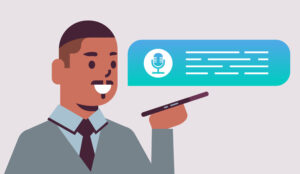Tom Risbrook reveals how speech-based ‘intelligent call steering’ can be used to delight your customers while making life a lot easier for your staff.
At the recent Innovators Awards – run by Scottish Financial Enterprise (SFE) in partnership with Ernst & Young – Standard Life won the top award in the general insurance, life assurance and pensions sector. This was thanks to ‘Sheila’, its natural language voice recognition (NLVR) system.
At Standard Life, ‘Sheila’ humanises the often frustrating and time-consuming experience of using traditional push button call routing technology, by understanding and interpreting what each customer says in a natural and conversational manner.
“customers don’t just want ‘a person’, they want ‘the right person’ – and as quickly as possible.”
Not only does this minimise the number of misdirected calls, but customer satisfaction is enhanced as all the user has to do is say what they require, without waiting for the correct touchtone menu option.
The Standard Life solution is also used to provide ‘identification’ and ‘verification’ of existing customers and access to self-service applications. When a customer is connected to an agent, the details the caller has given to Sheila are already on the agent’s screen together with their records, so removing the frustration of having to repeat everything.
Managing growth
In recent years contact centres have grown at a dramatic rate, responding to a diverse range of customer needs. With multiple products and services – sometimes from different companies – all being handled by the same group of call centre agents, there is the constant dilemma of how to maintain and improve customer service while dealing with growth, competition and agent churn.
Contact centre technology investment has focused largely on the areas of web, telephony and customer relationship management, while the adoption of self-service touch-tone technology and computer telephony integration (CTI) has been at a much lower level.
Further, touchtone technology has often been badly implemented, resulting in most automated systems having a poor reputation for service delivery. This is, at its most extreme, where customers face complex menu selections that are several layers deep. As a result, they often struggle to express their detailed requirements via the press of a button.
Increasing dissatisfaction with touch-tone has caused a number of high-profile companies to highlight their very lack of automation in advertising campaigns, with calls being answered by ‘real people’. Yet this overlooks one of the key complaints customers have against call centres: customers don’t just want ‘a person’, they want ‘the right person’ – and as quickly as possible.
So how do you achieve this? The following common, yet arduous, methods are used individually or in combination by the majority of call centres today:
- “Real people”, who are used to answer the calls directly. If they are experienced agents they will handle the call directly, but sometimes the first agent will lack the skills or knowledge to deal with the issue. In such cases, the caller is then transferred to another agent and already the customer experience is on a downward path. As a result, high rates of misdirected calls and long hold-times are common.
- Touch-tone menus, which offer another approach. Making the menu too short may lead to the need for routing by a service agent. By contrast, having too many options lengthens the time taken to get to an agent and results in higher abandoned call rates. Again, high rates of misdirected calls and long hold-times are common here. Typically, large UK contact centres experience between 10% and 30% misdirected calls, with up to 30 seconds per call of wasted agent time.
- Different telephone numbers for each department, product or service – these simply export the touch-tone problem onto the telephony network. Callers will either use the same telephone number (regardless of the reason for their call) because it is pre-programmed in to their phone, or will call the number on the last piece of correspondence they received.
Speech-based ‘intelligent call steering’
It does not have to be like this, however. An ‘intelligent call steering’ solution, for example, solves this problem by enabling all calls to arrive on one number, with the caller greeted by a common phrase: “Welcome to XYZ company. How can I help you?”
The caller is routed to the right agent within 20 to 30 seconds of the call being answered, with misdirected calls reduced to 5% or lower. Abandoned calls are reduced by up to 70%. Customer satisfaction is also enhanced because all the customer has to do is to say what they require, without waiting for the correct touchtone menu option, or worry about which number to dial.
For most calls, the caller’s identification and verification is required for the caller to gain access to their records and to guard against fraud. This process typically takes between 30 and 60 seconds. At busy times, this is wasteful of both the caller’s and the agent’s time, and makes the agent an interrogator – not exactly the best way to establish a good relationship.
By automating the identification and verification process using speech recognition, however, the caller’s identity and records can be popped on the call centre agent’s screen, telling the agent if the identification has been successful. The agent knows who is calling, why they are calling and has the caller record on screen before they take the call. This creates a much better first impression.
Further, automated identification and verification enables rigorous audit trails to be maintained for security compliance purposes, and provides a higher level of security and privacy.
As a result, such solutions eliminate the long hold times experienced by callers waiting to speak to an available call centre agent. They also increase the caller’s satisfaction by removing the need to struggle with confusing push-button menus.
This is achieved by utilising the latest in speech recognition and communications technology in order to ‘understand’ the caller and allow them to simply say what they want in the same way that they would speak to a call centre agent.
This essentially helps customers in three distinct ways. Firstly, it ascertains what the call is about and, where necessary, takes the customer through the security checks quickly and efficiently in order to fully authenticate the customer. Depending on the issue, the system can then answer the query or transfer the caller to a customer service representative (CSR).
Critically, it transfers the call to the right department and, what is more, the details the customer has already given appear on the screen in front of the relevant member of staff, so the customer does not have to go through the frustration of having to repeat their answer. The system is highly intuitive and mirrors the interaction a caller would have had with a CSR.
Maintaining customer service

Standard Life’s NLVR system has already delivered major operational and customer service improvements including, for example: a 25% capacity and flexibility increase for handling calls in the tele-servicing centre, through the promotion of self-service; a 66% reduction in misrouted calls by better first-time routing to the right advisor, resulting in higher levels of first call resolution; and an improved security check process saving up to 40 seconds per call, both consistently and auditably.
Importantly, all these gains have been achieved while maintaining the already impressively high level of customer satisfaction and service.
Tom Risbrook is sales and marketing director at VeCommerce
The following comments have been posted relating to this article:
I’m not sure that an automated voice systems really do improve customer satisfaction. The real driver cannot be customer satisfaction but cost reduction. I think that if you really wanted to increase customer satisfaction a better approach would be to multi-skill the agents so that they can deal with any call. (posted by Tim W)
The churn rate within the industry is a bit of a barrier to spending money on training agents to deal with any eventuality.
Author: Jonty Pearce
Published On: 5th May 2007 - Last modified: 19th Dec 2018
Read more about - Technology, IVR Solutions, Language





































